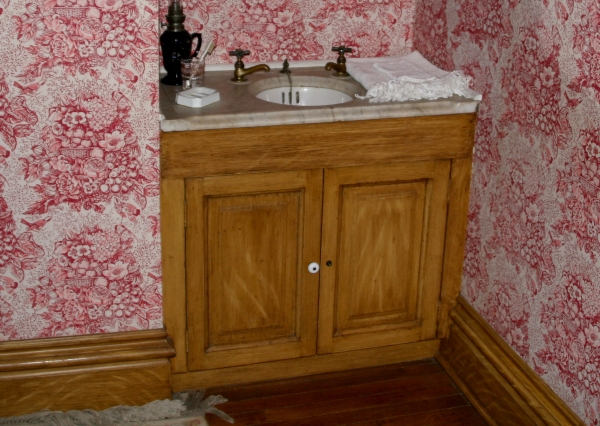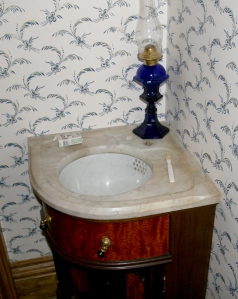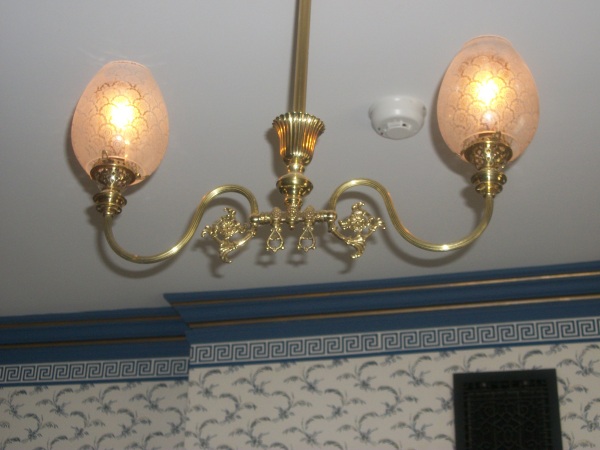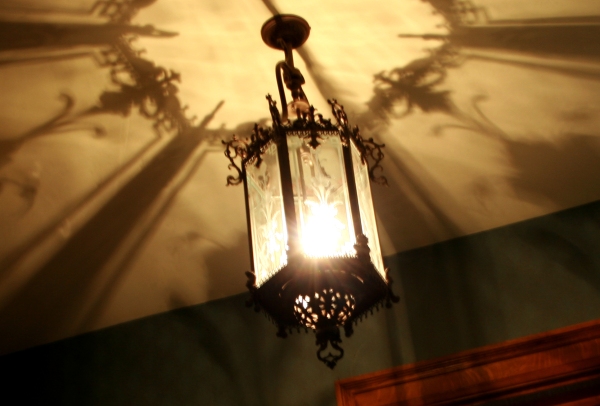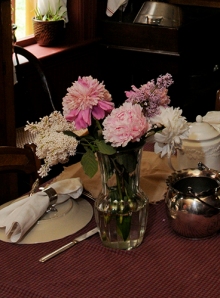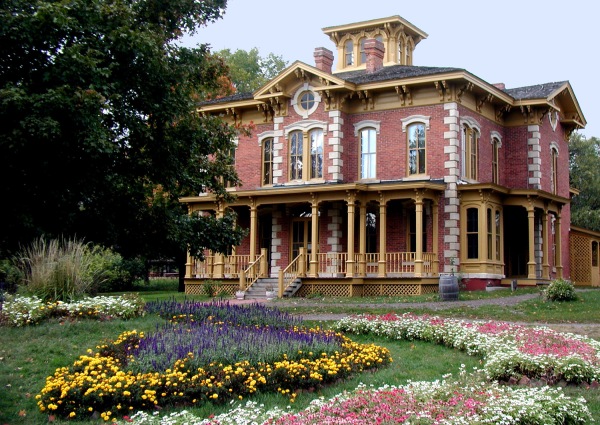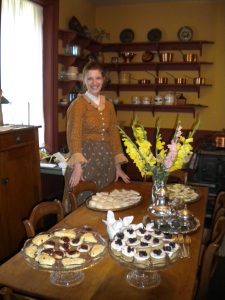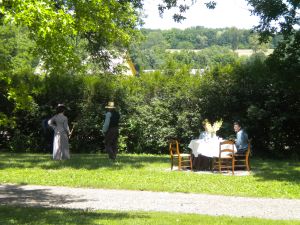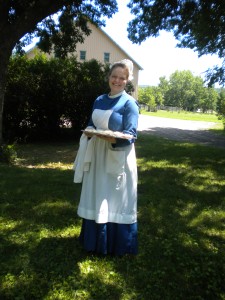The Flynn Mansion Blog has moved
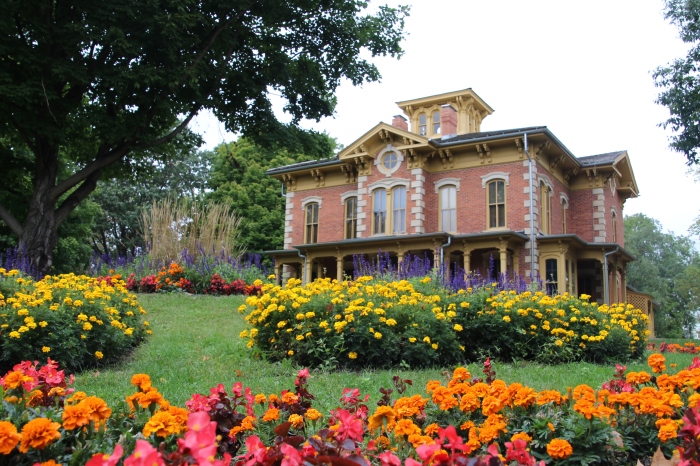
The Flynn Mansion blog has moved! We’ll still be posting interesting articles and updates from the Flynn Mansion, but now you’ll find them at the Living History Farms blog. In addition to information about the Flynn Mansion, you’ll find articles by our museum staffers describing the work they do, the artifacts and animals they work with, and the history that inspires them every day, from all around the museum.
Science of Flynn, Part II: Indoor Plumbing
In our last post, we mentioned an Iowa State Register article from 1871 that spoke of the modern comforts and conveniences Martin Flynn used to create his ideal country home. One of these luxurious features was indoor plumbing. Many of our visitors at Living History Farms are very surprised by this amenity, particularly since many Iowa farms didn’t have indoor plumbing until decades into the 20th century. Though the house did not have the number of bathrooms we would consider necessary for a large household today, for the time period, it was considered to be well appointed. Today, visitors to the Flynn Mansion can see three sinks in the house: two upstairs in bedrooms and one in the front kitchen. In addition to the sinks, the home had one bathroom with a sink, bathtub and a toilet. The bathroom was located between the master bedroom and the girls’ bedroom on the second floor at the head of the front stairs. The bathroom is not open to visitors at the present time.
Private water systems and city plumbing were appearing on the East Coast and in large Midwestern cities like Chicago during the two decades prior to the construction of the Flynn House. What makes the Flynn’s water system significant is its location in central Iowa. At that time, a few of Des Moines’ largest and most expensive homes, such as B.F. Allen’s Terrace Hill, were designed to have indoor plumbing; this, however, was the exception and not the rule. It should be noted that the Des Moines Water Company (now the Des Moines Water Works) was not even founded until the year 1871, the year that construction on the Flynn House was completed. Though Valley Junction, now West Des Moines, first attempted to establish the Valley Junction Water Works in 1899, action was not taken on the matter until the 1910s*.
Since public water was not available to the Flynns, the home had a private system. The house’s design incorporated tanks, cisterns, and pumps which were supplied with water from springs on the property (these springs also provided water for the farm’s animals). The water from the spring was gathered in a cistern below the house and forced to a collecting tank in the third-floor attic by a steam-powered pump. Gravity would then carry the water through the pipes to the sinks and fixtures throughout the house. We also believe the Flynns had hot water, which would have been heated by a boiler located somewhere in the kitchens.
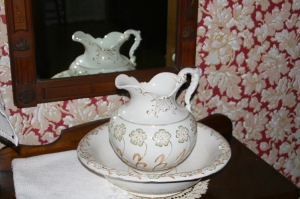 Today the fixtures we have in the house are representative of plumbing fixtures that would have been available to a family in the 1870s. While it seems possible that all four bedrooms in the front of the house would have had sinks, work during the home’s renovations found surviving pipes in only two of the front bedrooms. Instead of speculating, staff decided to put pitchers and basins in the other rooms instead.
Today the fixtures we have in the house are representative of plumbing fixtures that would have been available to a family in the 1870s. While it seems possible that all four bedrooms in the front of the house would have had sinks, work during the home’s renovations found surviving pipes in only two of the front bedrooms. Instead of speculating, staff decided to put pitchers and basins in the other rooms instead.
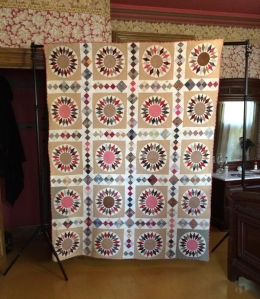 This week is the perfect time to visit the Flynn Mansion and learn more about its modern amenities! In addition to learning about the Science of Flynn, visitors to the mansion have the opportunity to view seldom-seen textiles and quilts from the museum’s collections as part of our Historic Textile and Quilt Show. We’d like to give a big “thank you!” to everyone who voted for us in the first round of the Iowa Icon Challenge, and urge you to continue your support in the second round!
This week is the perfect time to visit the Flynn Mansion and learn more about its modern amenities! In addition to learning about the Science of Flynn, visitors to the mansion have the opportunity to view seldom-seen textiles and quilts from the museum’s collections as part of our Historic Textile and Quilt Show. We’d like to give a big “thank you!” to everyone who voted for us in the first round of the Iowa Icon Challenge, and urge you to continue your support in the second round!
Vote here: http://dmreg.co/1qpOqrp (we’re in the Science category).
*For more information on the history of the Des Moines Water Works or the West Des Moines Water Works, please visit their websites at www.dmww.com and www.wdmww.com
A Light In the Country; The Science of Flynn, Part I: Gas Lights
While the Flynn Mansion was being constructed between 1870 and 1871, newspapers eagerly covered its progress, as well as its style and amenities. On August 15, 1871, an article appeared in the Iowa State Register which revealed “[t]he building is to be lighted with gas, to be manufactured on the premises, and consequently gas pipes have been put throughout the whole house.” For a home far from a city in 1870, particularly in Iowa, having gas lighting was something quite notable. It was a strong indicator that Mr. Flynn wanted the most modern conveniences and comforts for his home, and that he was willing to spend the money to acquire them.
In the middle part of the 1800s, domestic gas lighting relied upon gasses produced as byproducts from burning bituminous coal. These early systems did have some downsides, including a strong odor and occasional smoke. Scrubbers and filters were added in the 1840s and 1850s to help address those problems. By the 1870s, additional improvements in technology made it a more pleasant and effective lighting system.
Though gas pipes were found during renovations of the Flynn House, the portable gas production system is no longer there. We do not have records that indicate what particular type of system was originally installed, but we can draw some conclusions from what was available to a family like the Flynns during the time of the home’s construction. One of the more popular systems during the 1870s was the Springfield Gas Machine.
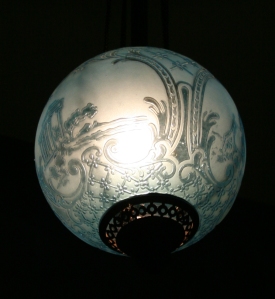 The Springfield Gas Machine was a two-part system which included a weight-driven air pump located in the house’s basement and a gasoline powered generator which was located underground at distance of at least fifty feet. Air from the basement pump would be forced through pipes to the outside generator. The air-gas mixture would then return to the house through pipes where it would be dispersed to the various fixtures, called “gasoliers”. The weight connected to the air pump would self-adjust as burners were turned off and on to maintain constant pressure throughout the system.
The Springfield Gas Machine was a two-part system which included a weight-driven air pump located in the house’s basement and a gasoline powered generator which was located underground at distance of at least fifty feet. Air from the basement pump would be forced through pipes to the outside generator. The air-gas mixture would then return to the house through pipes where it would be dispersed to the various fixtures, called “gasoliers”. The weight connected to the air pump would self-adjust as burners were turned off and on to maintain constant pressure throughout the system.
For more information on gas lighting, or the other technological advances that made the Flynn Family’s home one of the most enviable farmhouses in the state, please come out and visit us at Living History Farms! Don’t forget to vote for the Flynn Mansion in the Scientific Icon section of the Iowa Icon Challenge. Visit http://dmreg.co/1qpOqrp to learn more and to cast your vote! We are in the “Science” category.
Message in a Blossom: The Victorian Language of Flowers
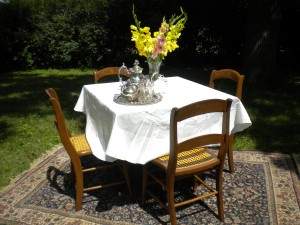 Ever since ancient times, flowers have held both practical and cultural significance. Whether the question at hand was decoration, medicine, or the wooing of a potential mate, men and women have turned to flowers for help. But during the Victorian era, flowers took on a very particular social significance due to the development of an elaborate system of floral symbolism called the “Language of Flowers.” In other words, a bouquet was no longer simply a bouquet; it was a secret message, and one had to know the meanings of the flowers that composed it in order to decode it.
Ever since ancient times, flowers have held both practical and cultural significance. Whether the question at hand was decoration, medicine, or the wooing of a potential mate, men and women have turned to flowers for help. But during the Victorian era, flowers took on a very particular social significance due to the development of an elaborate system of floral symbolism called the “Language of Flowers.” In other words, a bouquet was no longer simply a bouquet; it was a secret message, and one had to know the meanings of the flowers that composed it in order to decode it.
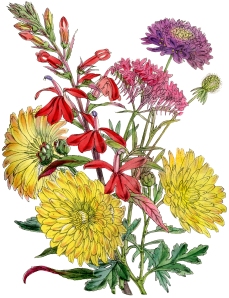 The first recorded instance of a structured floral language appeared in the early eighteenth century when Lady Mary Wortley Montagu noted that women in Turkish sélams used flowers to pass along messages. One hundred and fifty years later, communicating through floral symbols became a popular pastime for educated, upper- and middle- class people like the Flynn family. Publishers began releasing “dictionaries” that included the symbolic meaning of hundreds of flowers, trees, shrubs, fruits, and other plants. One such book resides in the ladies’ parlor of the Flynn home. By thoroughly perusing the pages of these dictionaries, readers would learn which flowers expressed love, which indicated friendship, and which could be used as insults.
The first recorded instance of a structured floral language appeared in the early eighteenth century when Lady Mary Wortley Montagu noted that women in Turkish sélams used flowers to pass along messages. One hundred and fifty years later, communicating through floral symbols became a popular pastime for educated, upper- and middle- class people like the Flynn family. Publishers began releasing “dictionaries” that included the symbolic meaning of hundreds of flowers, trees, shrubs, fruits, and other plants. One such book resides in the ladies’ parlor of the Flynn home. By thoroughly perusing the pages of these dictionaries, readers would learn which flowers expressed love, which indicated friendship, and which could be used as insults.
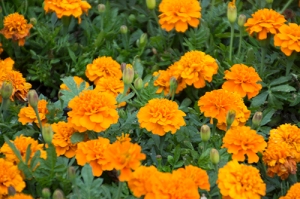 For example, the dictionary in the Flynn House associates marigolds with grief, pain, and trouble; on the other hand, it lists day lilies as a symbol of flirtatiousness and coquetry. Such volumes could also shed light onto the subtleties of the system, as the color of the bloom could change its meaning. For instance, white violets were known to symbolize “innocence,” while a purple violet indicated feelings of romantic love.
For example, the dictionary in the Flynn House associates marigolds with grief, pain, and trouble; on the other hand, it lists day lilies as a symbol of flirtatiousness and coquetry. Such volumes could also shed light onto the subtleties of the system, as the color of the bloom could change its meaning. For instance, white violets were known to symbolize “innocence,” while a purple violet indicated feelings of romantic love.
In addition to being an amusing pastime, this complicated system of conveying messages with blossoms saturated the popular culture of the mid to late 19thcentury. Flower dictionaries often contained botanical information and novelty items like calendars in addition to their lists of definitions. Beyond the books themselves, magazines like Harper’s Monthly and Godey’s Ladies’ Book included features that referenced the Language of Flower, including poems and pictures. There was even a popular parlor game in which blindfolded party guests would pick a flower from a vase. The blooms chosen were meant to tell players something about their future love or personality.
The Language of Flowers was attractive to Victorians for several reasons. There was an increased interest in botany during this period as it became fashionable to “bring the outdoors inside” to decorate one’s home. In addition, ownership and deep knowledge of a Language of Flowers manual provided a sort of cultural capital for Victorians. The volumes enhanced one’s library, which helped to demonstrate how well a family was doing financially. Learning the language was also deemed an appropriate and instructive accomplishment for young ladies. Finally, floral symbolism provided a unique avenue for personal expression. Victorian rules and mores put strict controls on what ideas and feelings could and could not be expressed in conversation; flowers gave people the unique opportunity to communicate more personal or daring messages visually without directly flouting the rules of polite society.
Submitted by Sarah Purdy
Reference List
Jabaay, Judy, Living History Farms, “Language of Flowers, Fall Teas 2007.”
Sheley, Nancy Stow. “The ‘Language of Flowers’ as Coded Subtext: Conflicted Messages of Domesticity in Mary Wilkins Freeman’s Short Fiction.” Working Papers on Design 2 (2007): 1-25.
The Language and Sentiment of Flowers. Bedford, MA: Applewood Books, 2003.
“The Language of Flowers.” BBC. Last modified September 22, 2005. http://new.bbc.co.uk/dna/place-lancashire/plain/A526085.
“The Language of Flowers.” Smithsonian Gardens. n..d. http://gardens.si.edu/come-learn/docs/Template_HistBloom_Language%20of%20Flowers.pdf.
“The Victorian Language of Flowers.” Springhill Gardes. n.d. http://www.springhillfriends.org/ Docs/Attachlanguageofflowers.pdf. 1-5.
Taking Tea in the Garden
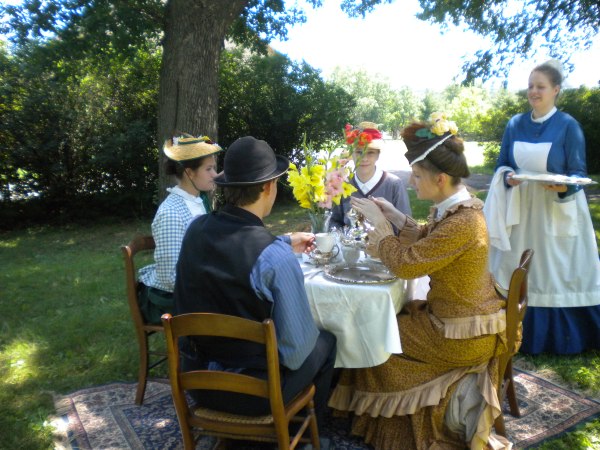
As Kate pours tea and maid Sarah offers a tray of sweets, Kathlee, Rebecca and Ben enjoy sitting in the garden.
A beautiful rug, sparkling silver, and brilliant flowers: the scene is set for garden tea outside the Flynn Mansion. On a lovely Sunday afternoon in July, several staff members, interns, and volunteers created their own garden tea on the lovely grounds outside the mansion. Tea was a popular beverage in Victorian America, but it was traditionally taken indoors. However, on a lovely spring or summer afternoon, the garden could provide a picturesque alternative location.
Victorians loved to bring nature inside their homes displaying plants, shells, images of flowers and animals, etc. However, did you know that they also brought the indoors outside? Yes, even down to an ornate rug, the entire parlor tea scene was brought outdoors. In doing so, one could enjoy nature in a controlled way while still adhering to the strict rules of etiquette that characterized the Victorian Era. Of course, it did not hurt that a lady could also show off her gardening and baking talents at the same time. Guests would be treated to beautiful views of flowers, the shade of lovely trees, and delicious treats from the hostess’s kitchen. Tea was often served with an assortment of cakes and sandwiches.
At our tea, we served lemon cake with raspberries decorating the top in addition to an assortment of cucumber, ham, and egg sandwiches. The delicacies were served by one of our talented interns playing the role of maid, while others sat down to a lovely afternoon observance of a delightful Victorian custom. We hope you can join us for our next Garden Tea.
Submitted by Kathlee Yates, Judy Jabaay
